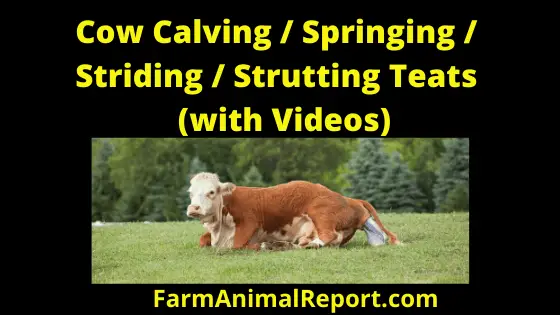Cows Calving Strutting
Cows Calving Strutting – The whole bovine labor and delivery process is usually over in less than eight hours. Typically, the cow goes into labor and gives birth without any problem. Nevertheless, it is crucial to be there for the delivery just in case this time is an exception, and the cow is experiencing birth difficulties or the calf has an issue.
If the cow is due to give birth, examine her at least three times a day, looking for any physical or behavioral changes. If she is a heifer and it is her first pregnancy, check the heifer more often.
To learn more about Raising Cattle Check out Amazons Resources
Predicting when a cow will calve is as much an art as a science. While some signs of impending calving are apparent, others depend on close and knowledgeable observation.
SELECTION OF COW BASED ON TEATS: –
The conformation of cow’s teat and udder are vital in a profitable cow/calf enterprise. The female cow with poor teats and udder conformation is a management challenge for the commercial producers.
The cattle producers don’t have much time or labor to manage around cows that require intervention at calving to physically milk out a quarter so that the calf can suckle or save the quarter from the infection.
The poor conformation of teat and udder can lead to increased calf sickness as teats may be contaminated with debris and mud, or calving area before the calf suckles.
The selection and culling based on confirmation of the teats and udder may be considered convenience trait selection. Selecting against poor teats and udder enhances profit potential by reducing the calf performance, increasing the longevity of the cow, improving the calf performances, and reducing the labor input.
Udder and teat conformation are moderately heritable, so
enhancing teat and udder quality can be accomplished by not selecting replacement heifers from dams that have marginal teat and udder conformation.
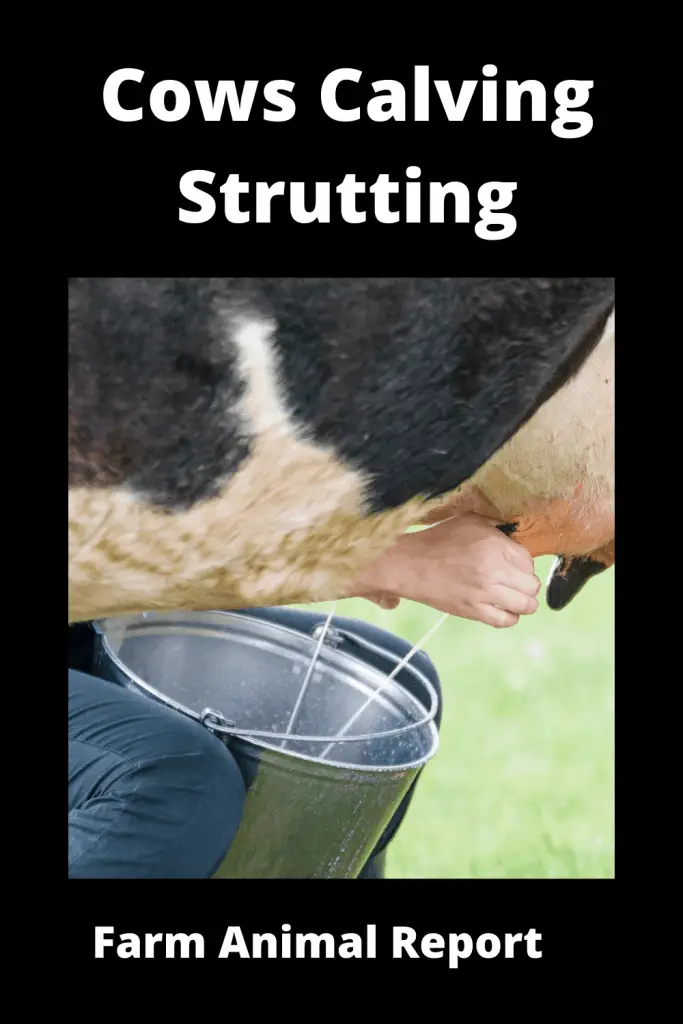
BOVINE GESTATION
The gestation period for cows is 283 days or a little over nine months. It is easy to figure out the due date from when the cow was bred or inseminated. Ten-day early or late falls within the normal range.
The gestation period would be the same as the previous calving. A cow might carry a bull calf a few days longer than a heifer, based not on the older farmer’s tale but influences of the hormones. When selected a bull as a sire, consider the gestational dates of their young ones. In certain lines, the gestational period is a bit longer and it is better to avoid it.
See Our Guide – Ways to Make Money Cattle Farming
CERVICAL DILATION
The dilation of the cervix starts just before calving, with the cervix closed before the point. It is necessary to know how many fingers should insert into the cervix. In old cows, it is possible to insert four fingers in the closed cervix.
PHYSICAL SIGNS
As the cow becomes ready to give delivery, physical changes give the caretaker clues that labor and delivery are imminent. The physical signs that occur in the cow are:
- Udder become filled usually within two weeks of birth
- The relaxation of pelvic ligaments. These ligaments are between the tail head, and the buttock point starts sinking within 12 to 24 hours of delivery. However, it is hard to observe in overweight cows.
- There would be strutting of the teats in the cow.
- The strutting of teats is when the teats start pointing outward rather than hanging down.
- The relaxation of the vulva can be seen in near parturition.
Behavioral CHANGES
Near to the onset of the labor, the cow will likely isolate herself from the rest of the herd. The cow may become restless, and has little or no interest in the food. As the labor progresses, the cow may get up and down, and lift the tail.
The heifer will be more in pain and look uncomfortable than a cow that has had several calves before. The experienced cows have the ideas of what is coming and tend to take it more in stride. The initial stage of labor remains between two to six hours. The cow begins straining and arching her back.
TEMPERATURE CHECKING
The temperature of the cow is also an indication of the labor. Generally, the temperature of the cow drops about 12 to 24 hours before giving birth.
SPRINGING AND STRIDING IN COWS: –
Mostly, the loss of calves during calving is often resulting in dystocia or difficult calving problems. Usually, the injuries are more during the first-calf heifers. They can be prevented if the heifer and cows are watched closely and the problematic birth issues detected and corrected early.
As the calving season approaches, the cow will show typical signs that will indicate that parturition is imminent. The most frequent changes that can be observed include the development of the udder, swelling of the vulva, springing, and mucus discharge.
This springing and striding in cows is an indication that the cow is near to calving.
There are a few differences between the individuals in the development of these signs and certainly, age is also a factor.
The first calf heifer, particularly of milk breed, may develop udder for a very long time, sometimes a couple of months before the parturition.
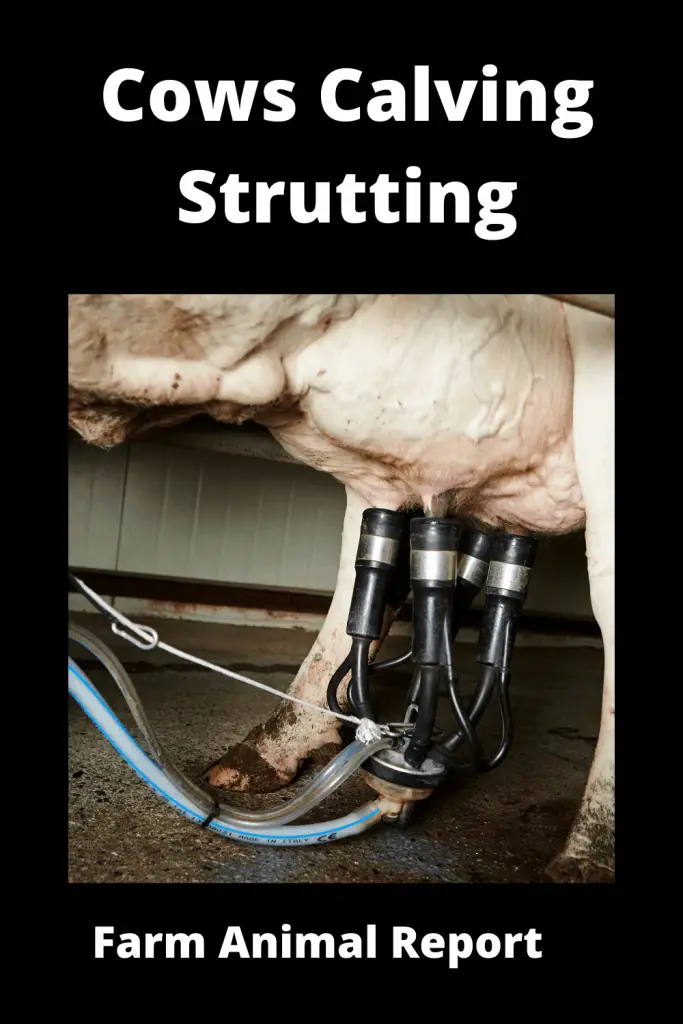
The springing in cows can be highly variable too. Mostly, people may observe that Brahman influence cattle seem to spring much more as compared to the Holstein.
Usually, in the next two weeks before calving, springing becomes more prominent in cows with the filling of the udder, and one of the things that might be seen is the loss of the cervical plug. The cervical plug is a very thick tenacious, mucous material dropping from the vulva of the cow. It may be seen pooling behind the cow when the cow is lying down.
RECOGNIZE NORMAL CALVING
PRE-LABOUR
The first sign of calving is the development of the udder. It starts enlarging as early as six weeks before the cow calves or may suddenly fill during the last few days. The udder of some cows is so developed that it seems like that the calving is about to happen, but they go many more days before the actual event.
The tissues around the birth canal become softer, and the vulva becomes enlarged and flabby. The floppy vulva is the indication that the cows or the heifers are approaching calving.
The ligaments of the pelvis become relaxed too. The area between the tail head and the point of the buttock on each side of the tail appear sunken. Labor will typically begin about 12 hours after the complete relaxation of those ligaments.
Other signs of impending labor include mucus discharge from the vulva as the cervical plug softens and excluded. A long cord of mucus may suspend from the vulva.
3 STAGES OF PARTURITION: –
If the calf is normal position and the pelvic area is large enough, then mostly the cow will give birth without any assistance. Recognizing normal calving is essential just like knowing when the calving is abnormal. There are three stages of parturitions and are:
STAGE 1
The dilation of the cervix is the initial stage of parturition. The normal cervix is tightly closed right up until the cervical plug (thick mucus hanging from the vulva) gets dissolved entirely.
The cervical dilation occurs four to twenty-four hours before calving. During this stage, the progesterone hormone block is no longer affected and the muscles of the uterus become more sensitive to the factors that can enhance the rate and strength of the contractions.
Initially, the contractile forces primarily affect the relaxation of the cervix, but the muscular activity of the uterus remains quiet. This stage 1 goes unnoticed, but there are a few behavioral changes like isolation or discomfort in the cows. There may be the elevation of the tail, twisting of the rear, and increased mucous discharge at the end of stage 1.
STAGE 2
It is known as the stage of the delivery of the newborn. It initiates the entry of the membranes and fetus into the pelvic canal and ends with the complete birth of the calf. Clinically, stage 2 is marked by the appearance of the water bag or the membranes at the vulva.
The second stage in cows lasts for two to four hours. The older cows had deliveries before and the birth is quite rapid as compared to the heifer whose pelvic opening is small and the soft tissue has never been expanded.
STAGE 3
The shedding of the placenta or the fetal membranes happens in the stage of parturition. In cattle, this stage occurs typically in less than eight to twelve hours. The layers if remained there for more than 12 hours, it is known as the retained placenta. Administration of antibiotics will help to avoid any infection and the retained placenta will slough off within four to seven days.
However, some people may think that this happens immediately before the parturition. Still, this can be seen before calving and therefore is only another sign that the calving season is nearby.
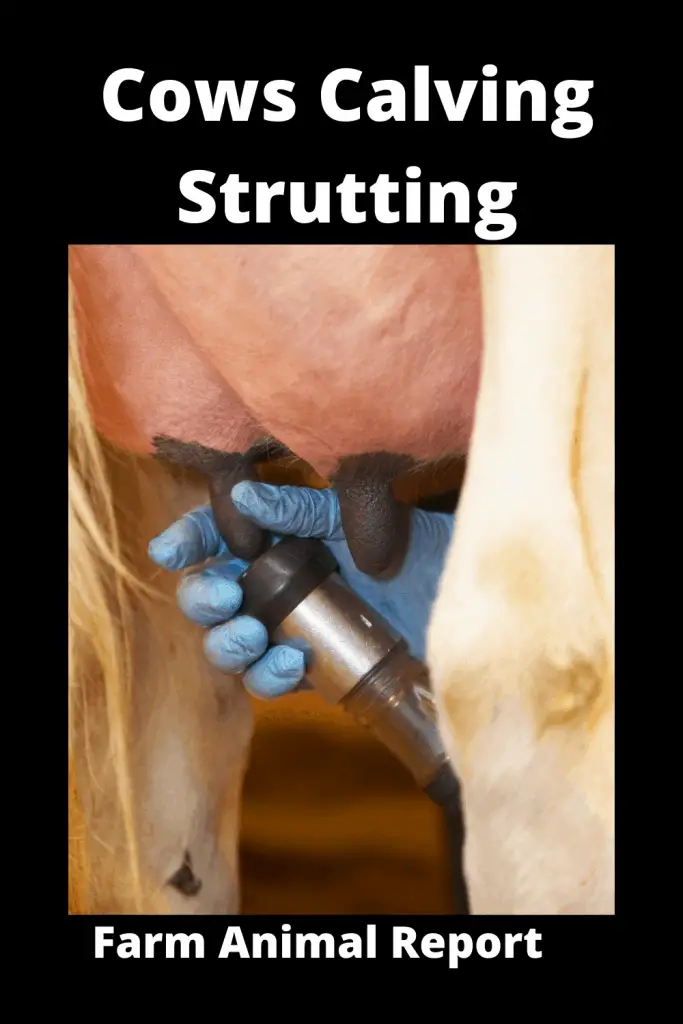
SIGNS OF PARTURITION: –
The immediate signs that generally occur 24 hours before calving include the relaxation of the pelvic ligaments and strutting of the teats. These signs are depending on the owners that watch them several times a day during the calving season may help to know about calving. To The casual observer or inaccurate knowledge makes it difficult to predict the calving time.
The relaxation of pelvic ligaments cannot be observed in fat cows. However, the relaxation of pelvic ligaments clearly seen in thin cows. The relaxation of the ligament is the clue in thin cows 12-24 hours before calving.
The strutting of teats is not very dependable in the cows. Some heavy milking cows may have the strutting of the teats as much as two or three days before calving. However, the thin cow with inadequate milking capacity will calve without any strutting of the teats.
Other behavioral changes in cows before the parturition includes feeding, isolation, discomfort. However, most of the cows don’t show many behavioral changes before the parturition process starts.
The transition period from the last weeks of dryness to the initial phases of lactations is the vital time for setting the cows up for milking and joining. This transition produces a lot of stress on the cow, and if the cow doesn’t get proper management. The issues that may develop are: –
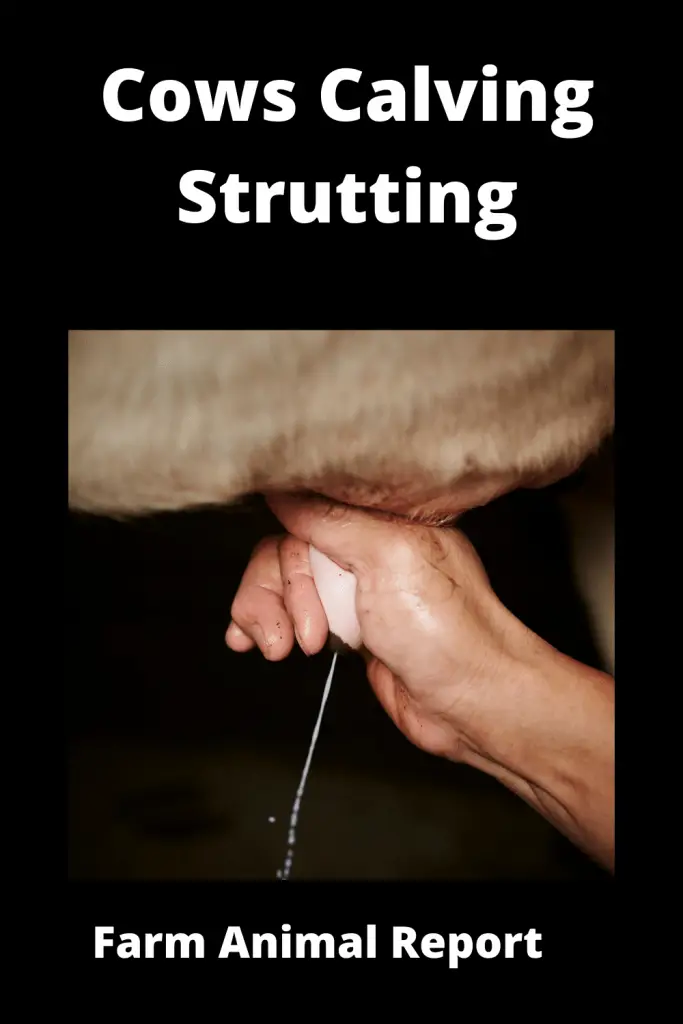
- The calf is growing, and it requires more nutrients
- The appetite of the cow may reduce with the growing size of the calf.
- The onset of lactation requires a tremendous amount of energy, protein, and minerals into the milk.
All these issues mentioned above mean that there is great potential for clinical and production limiting deficiencies in the transition or the Springer cow.
NOISES DURING CALVING: –
A cow usually makes noises if they are under stress. Cows typically communicate with each other via sounds. A cow regularly makes grunting noises that the unborn calf can hear. The cow will continue to make that noise after the birth for a few days so that both cow and calf make a healthy relationship.
Cows that are yarded for the first time sometimes make bellowing noises, as they feel scared of a new situation. The make of these sounds also enhances milk production in cows.
UDDER CHANGES DURING PREGNANCY: –
STAGE ONE: DILATION OF CERVIX
it is essential to know the changes that occur during birth before understanding the alternation in the udder during pregnancy. Milk is not taken from the mother cow until after the weaning of the calves. Cows are not milked during pregnancy, nor do they produce milk.
The udders look normal during the pregnancy with slight swelling. The udder starts changing once the birthing begins, which starts with the dilation of the cervix. This dilation can start 24 hours before the actual birth begins and a noticeable swelling or growth in the udders is joint.
The uterine muscles of the cow are very quiet during this period, and the dilation may go unobserved. However, additional signs to look for are any behavioral differences or discomfort with the cow.
STAGE TWO: DELIVERY
During the 2nd stage of the birth, the udder begins to moisten or slightly drip. This dampens a typical sign of healthy delivery and it is a collective experience as the calf is delivered. If the pregnancy doesn’t happen at the expected time or lactation appears to be going on in the udder early, the most elegant option is to induce labor for the cow.
The induction of labor in the cow is necessary to avoid excessive udder edema (a metabolic problem where udder produces excessive fluid) after the birth and also to ensure that the udder support doesn’t become damaged.
Udder edema usually happens in the cow during or after calving but is not much harmful. However, it can cause harm later if the cow is intended for dairy purposes as damage to the udder could occur.
STAGE THREE: SHEDDING OF THE PLACENTA
During the 3rd stage of pregnancy and after parturition, the udders can appear swollen for 24 hours. After that, the placenta and fetal membranes have shed, the calf will start feeding.
The swollen udder will remain enlarged but return to normal-looking later on. The calf feeding will help to strengthen the teat and the entire process is vital for dairy cows until the weaning process begins.
WHEN AND HOW TO EXAMINE THE COW
It is essential to know with complete confidence that when and how long to leave the cow and when to seek assistance. The main issue that the rancher may face at the calving time is the amount of time a heifer or a cow is required to be in labor before any help is given.
As mentioned above, stage 2 lasts for two to four hours in most cows. The heifer may show step 2 for the more extended time interval that may be approximately 60 minutes while in a mature cow, it lasts for 30 minutes.
Most ranches develop heifers fully and use calving ease bulls to prevent the difficulties that occur during calving. However, difficult births do occur each calving season. Using the basics of evening feeding to get more heifer parturition in daylight and giving help early may protect a few more calves. This results in healthier more productive two-year cows to rebreed next year.
If nothing is happening after a period of intensive straining of stage 2, then it is better to determine the presence of the calf—the washing of the vulva, anus, and the area between them with warm water and soap. Try to enter with the arm after using a disposable sleeve, and a good lubricant, making sure that nothing happens to the water bag. If the presentation is not standard, then assistance is required.
World Cattle Breeder Associations
| Cattle Association | Location | Link |
|---|---|---|
| National Cattleman's Beef Associations | United States | NCBA |
| United States Cattlemans Association | United States | USCA |
| Ohio Cattlemans Association | Ohio | OCA |
| American Angus Association | United States | AAA |
| United Kingdom Cattle Associations | UK | UKCA |
| Australia Cattle Associations | Australia | ACA |


